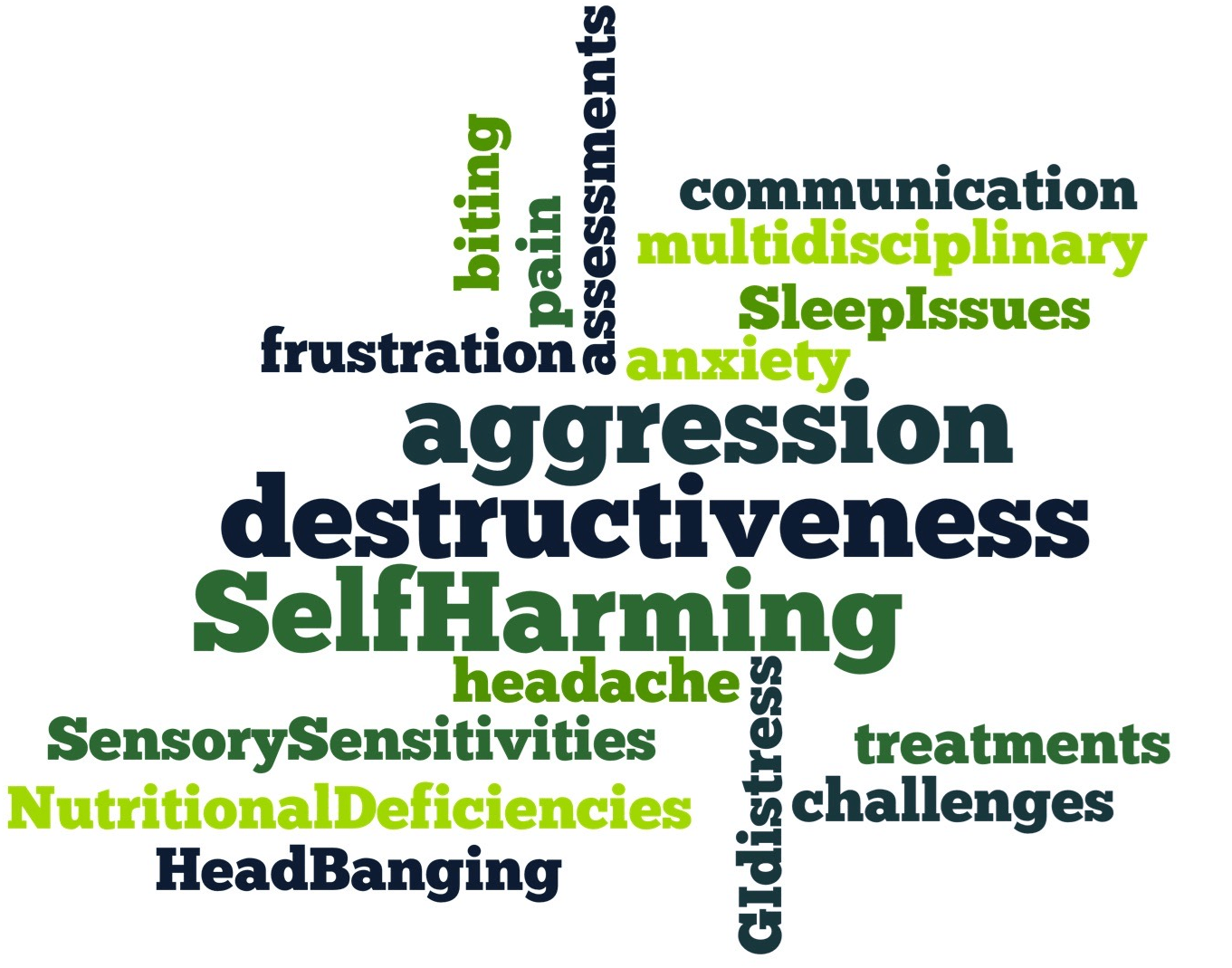
 Challenging behaviors such as aggression, destructiveness, and self-injury take a tremendous toll on adults with autism and their caregivers. Each week, the Autism Research Institute receives desperate communications from caregivers seeking help for an adult son or daughter whose behavior is disturbing, dangerous, or even life-threatening.
Challenging behaviors such as aggression, destructiveness, and self-injury take a tremendous toll on adults with autism and their caregivers. Each week, the Autism Research Institute receives desperate communications from caregivers seeking help for an adult son or daughter whose behavior is disturbing, dangerous, or even life-threatening.
In this editorial, I will look at the scope of this problem, current approaches for treatment, and the steps the autism community can take to help people with autism spectrum disorder (ASD) and caregivers who are struggling with this serious issue.

The high rate—and high cost—of challenging behaviors
Aggression, destructiveness, and self-injury are common among children with ASD, with the Autism Research Institute’s E-2 database of more than 2,300 cases indicating that 59% of those with ASD engage in one or more of these behaviors. Other datasets also support the relatively high prevalence rate of challenging behaviors in this population (McClintock et al., 2003; Matson and Rivet, 2008; Rattaz et al., 2018; Steenfeldt, Kristensen, et al., 2020). In a recent long-term follow-up study, Laverty et al. found that 44% of individuals with ASD continued to engage in self-injurious behaviors a decade later indicating that this behavior can be persistent and lifelong if not overcome (Laverty et al., 2020).
In children with ASD, challenging behaviors are a significant problem that can interfere with nearly all aspects of daily life. Later, as these children grow into adulthood, their bodies become larger and they become stronger. Consequently, these behaviors can become even more severe, significantly reducing these individuals’ quality of life and often endangering the people who care for them.
We hear reports from group home staff members who are “walking on eggshells” when they interact with some of their residents, in fear of unexpected outbursts (reviewed by Barroso et al., 2018). We also hear from parents who feel trapped and isolated in their own homes. They cannot bring their sons or daughters out of the house, and opportunities for recreation, employment, and residential placement are limited (see Chen et al., 2015 for a review of issues related to employment). This situation becomes even more dire in situations when there is only one parent or caregiver available to provide support.
To compound the problem, most physicians and therapists have little experience treating adults on the autism spectrum, so there is a dearth of experts who can provide effective support and guidance (Murphy et al. 2016). One common treatment option recommended by professionals is sedation, but sedative drugs can negatively impact cognition, sociability, and motor abilities. In addition, they do not address the underlying problems causing the behaviors.
Addressing the roots of challenging behaviors
The contributors to aggression, destructiveness, and self-injury can be classified into three categories: a biological basis, a social basis, and an initial biological cause that is later maintained by social consequences.
Examples of biological causes that may predispose to challenging behaviors include high arousal levels, often associated with anxiety (Casanova et al., 2021); medical comorbidities associated with pain or discomfort such as chronic constipation or GERD (Bauman, 2010; Muskens et al., 2017); or environmental sensory input such as certain loud sounds or bright lights (Miller and Misher, 2016).
There also can be social contributors to challenging behaviors. These include a desire for positive or negative attention, a desire to escape or avoid an undesirable task or situation, and a desire to acquire a desired object or situation (Carr, 1977).
In some cases, a challenging behavior may result from an underlying biological problem, usually associated with pain, but individuals learn that their reactions to the problem can result in positive social consequences such as attention. In a well-cited case study by Carr and McDowell (1980), a 10-year-old scratched himself to alleviate the pain from a severe skin allergy. After the initial problem cleared up, his scratching still continued because it was maintained by social attention. May and Kennedy (2010) review studies examining the relationship between organic and social contributors with respect to challenging behaviors.
It is important to mention that some challenging behaviors are associated with an underlying genetic condition (Shirley et al., 2016; Huisman et al., 2018; Kurtz-Nelson et al., 2020). This does not necessarily mean that the behavior is untreatable. In some instances, the primary metabolic or genetic lesion may be amenable to treatment; in other cases, the challenging behavior may be responsive to treatment of a co-morbidity that is associated with the genetic condition, such as GI related pain (Coleman, 2016; Kurtz-Nelson et al., 2020).
There are many assessments that can help shed light on the underlying reasons for challenging behaviors. Types of assessments can include clinical evaluations and laboratory testing, neurodevelopmental and psychological testing, and parent reports. Although many of the behavioral assessments have been validated in studies on children with ASD, most may also be relevant for assessing adults. A thorough multidisciplinary effort may be needed to uncover the underlying cause or causes of a behavior. This may take time to perform, and is variably covered by insurance policies.
Once the underlying reasons for challenging behaviors are uncovered, the most effective treatments may become obvious. In some instances, medical treatments can mitigate the impact of an underlying medical problem such as an infectious, inflammatory, or metabolic process. In other instances, nutritional, sensory, or behavioral interventions can be very helpful. In a number of cases, a combination of approaches may be needed to reduce or eliminate the behavior (Minishaw et al., 2015). For example, if a child engages in head banging, a neurologist might determine that this is due to head pain caused by a specific condition, and treat that condition medically. If this treatment is not completely successful, a therapist might also implement a behavioral strategy to discourage head hitting by teaching the individual alternate behaviors.
Needed: a coordinated effort to understand and treat challenging behaviors
Countless individuals on the autism spectrum and their families worldwide are dealing with challenging behaviors. Understanding the causes and pathophysiology of these behaviors and developing effective treatments must be a public health priority.
It is time for us to create a network to focus on understanding and treating challenging behaviors. This network should consist of all stakeholders in the autism community, including individuals with ASD, family members, clinical professionals, and policymakers. Among other efforts, this network should encourage specialized training for professionals and provide information for caregivers about what they can do at home and where they can find specialists in their area.
Clearly, there are no easy answers to the problem of challenging behaviors in ASD. However, we are stronger when we join forces. By working together, we can provide effective solutions for the millions of people with ASD and their families who are dealing with this difficult issue.
Stephen M. Edelson, Ph.D.
Executive Director, Autism Research Institute
Marvin R. Natowicz, M.D., Ph.D.,
Cleveland Clinic and Case Western Reserve University School of Medicine
This editorial originally appeared in Autism Research Review International, Vol. 35, No. 1, 2021
ARI’s Latest Accomplishments
Connecting investigators, professionals, parents, and autistic people worldwide is essential for effective advocacy. Throughout 2023, we continued our work offering focus on education while funding and support research on genetics, neurology, co-occurring medical
Biomarkers start telling us a story: Autism pathophysiology revisited
Learn about emerging research on biomarkers and autism from a recent ARI Research Grant recipient. This is a joint presentation with the World Autism Organisation. The presentation by Dr.
Editorial – Bernard Rimland’s Impact: Sixty Years Since the Publication of ‘Infantile Autism’
In this milestone year of 2024, the Autism Research Institute commemorates the 60th anniversary of Dr. Bernard Rimland’s groundbreaking work, Infantile Autism: The Syndrome and Its Implications for a Neural Theory of




